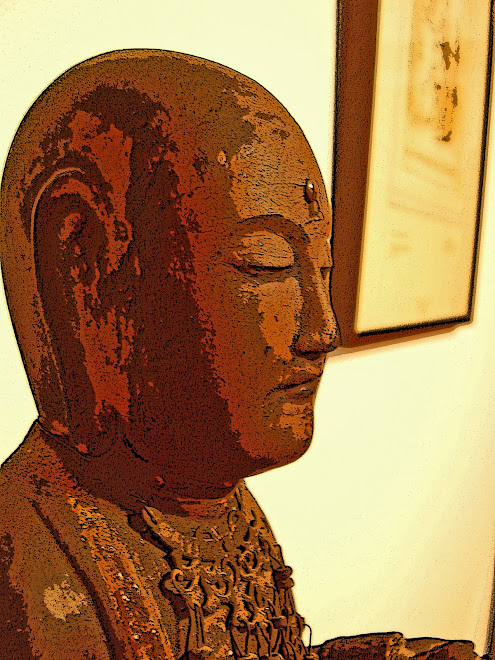左手に宝珠を持ち、右手に錫杖を執る声聞姿の立像である。平安後期に始まり、鎌倉期以降日本の地蔵菩薩像の典型となった形相に従っている。
胸に瓔珞を掛け、袈裟を着け、蓮台に立つ。光背を失する(台座に取付用の穴あり)。
袈裟に截金を施す。右肩に雲流文を、正面に菊花文などを、左袖に花菱文などを残す。
頭部が比較的大きい。面長で、落ち着いた面相である。
基台込み51cm、基台除き37cm。
A small wooden statue of jizo bosatsu.
The iconology to represent jizo as a standing figure of a priest holding a jewel ball on its left hand and a stick with its right hand emerged in late Heian period and has become prevalent since Kamakura period. The current statue follows this iconology.
The statue wears a necklace and priest’s clothes and stands on a lotus base. The halo, which should have existed, is missing.
The clothes are decorated with cut-gold patterns. There remain cloud-shape patterns on the right shoulder, chrysanthemum flower patterns on the front, and patterns of flower in diamond shape on the left sleeve.
The statue has a relatively large head with a calm, oval face.
51cm with base, 37cm without base.
写真をクリックすると拡大されます。Click photos to enlarge.
 「面白いことに、(右手の臂を屈げて錫杖を握る)この種の地蔵像には、右手に錫杖をもちながら、第一指と第三指を捻じるもの(京都清和院・滋賀観音寺)、あるいは第一指・第三指・第四指を捻じるもの(滋賀真迎寺)などもあって、そこになお(右手に何も持たず印を結んでいた古式像同様)印を結ぶ意識ののこっているのはみのがせない。(毛利久「地蔵菩薩像の形相」、仏教芸術97号)」
「面白いことに、(右手の臂を屈げて錫杖を握る)この種の地蔵像には、右手に錫杖をもちながら、第一指と第三指を捻じるもの(京都清和院・滋賀観音寺)、あるいは第一指・第三指・第四指を捻じるもの(滋賀真迎寺)などもあって、そこになお(右手に何も持たず印を結んでいた古式像同様)印を結ぶ意識ののこっているのはみのがせない。(毛利久「地蔵菩薩像の形相」、仏教芸術97号)」
この像は第一指・第三指・第四指を捻じる後者の型となっている。
 目鼻口は唐招提寺鑑真和上像に似るか
目鼻口は唐招提寺鑑真和上像に似るかThe eyes, the nose and the mouth somewhat resemble those of the Statue of Ganjin.
(鑑真和上像写真は和田義男氏)
 まず罪苦の人々を救って安楽ならしめ
まず罪苦の人々を救って安楽ならしめ悟りを得させてからでなければ、
自分は仏になろうと願うまい、という願を起こした。
(地蔵菩薩本願経)
`I will never become a Buddha if I have not first delivered all those sinful and suffering beings, making them comfortable and joyful and enabling them to achieve Bodhi.'
(The Sutra of Bodhisattva Ksitigarbha's Fundamental Vows)
地藏菩薩本願經
唐于闐國三藏沙門實叉難陀譯
閻浮眾生業感品第四
爾時世尊告定自在王菩薩。その時お釈迦様は自在王菩薩にこうお告げになった。
諦聽諦聽善思念之。よく聴け、よく聴け、よく考えてこのことを思え。
吾當為汝分別解說。おまえに一つ一つ説き明かしてやろう。
乃往過去無量阿僧祇那由他不可說劫。何千億年の何億倍もの更に説明もできないほどの昔に
爾時有佛號一切智成就如來應供正遍知明行足善逝世間解無上士調御丈夫天人師佛世尊。
ひとりの仏があった。名を、一切智成就如来・応供・正遍知・明行足・善逝・世間解・無上士・調御丈夫・天人師・仏・世尊といった。
其佛壽命六萬劫。その仏の寿命は六万劫だった。
未出家時為小國王。その仏は出家前は小国の国王だった。
與一鄰國王為友。そして隣国の国王を友としていた。
同行十善饒益眾生。ともに十種の善行を行い、人々のために働いた。
其鄰國內所有人民多造眾惡。その隣国の国民には、いろいろな悪行を為す者が多かった。
二王議計廣設方便。二人の王は相談して作戦を考えた。そして
一王發願早成佛道。一人の王はすみやかに仏道を成就して、
當度是輩令使無餘。人々を残りなく悟らせようとの願を起こした。
一王發願若不先度罪苦。もう一人の王は、まず罪苦の人々を救って、
令是安樂得至菩提。安楽ならしめ悟りを得させてからでなければ、
我終未願成佛。けっして自分は仏になろうと願うまい、という願を起こしたのだ。
佛告定自在王菩薩。お釈迦様は自在王菩薩にこうお告げになった。
一王發願早成佛者。速やかに仏になろうとの願を起こした方の王は、
即一切智成就如來是。すなわちこれが一切智成就如来なのだ。
一王發願永度罪苦眾生。衆生を罪苦から救い続けようとの願を起こし、
未願成佛者即地藏菩薩是。いまだに自分は仏になろうと願わないでいる者、それが地蔵菩薩なのだ。
link to 地蔵菩薩本願経全文
The Sutra of Bodhisattva Ksitigarbha's Fundamental Vows
Chapter 4: The Karmic Retribution of Sentient Beings in Jambudvipa
(Translation by Upasaka Tao-tsi Shih)
Then the World Honored One said to Bodhisattva-Mahasattva Samadhisvararaja, "Listen attentively! Listen attentively and think carefully about all that I say, for I am going to describe each vow individually for you.
"Think of that vastly ancient time ere immeasurable, asankhyeya, nayuta, inexpressible numbers of kalpas. At that time, there was a Buddha known as SARVAJNASIDDHARTA TATHAGATA, who had the epithets of Arahat, Samyaksambuddha, Vidyacarana- Sampanna, Sugata, Lokavid, Anuttara, Purusa-Damyasarathi, Sastadevamanusyanam, Buddha and Bhagavan. This Buddha had a lifespan of sixty thousand kalpas.
"Before he left his home life, he was the king of a small country. He befriended the king of the neighboring country, and they both practiced the ten virtues for the benefit of sentient beings. Since most of the people in the neighboring country had committed many wicked deeds, the two kings contrived a plan to provide extensive expediencies, whereby one of the kings made up his mind to achieve Buddhahood early in order to deliver all those wicked people without exception, while the other king took the vow: `I will never become a Buddha if I have not first delivered all those sinful and suffering beings, making them comfortable and joyful and enabling them to achieve Bodhi.' "
The Buddha, continuing to tell this story to Bodhisattva-Mahasattva Samadhisvararaja, said, "The king who made up his mind to become a Buddha earlier became TATHAGATA RVAJNASIDDHARTA; but the other king, who vowed always to deliver all sinful suffering beings and did not want to become a Buddha, is now Bodhisattva Ksitigarbha.
link to the full text of The Sutra of Bodhisattva Ksitigarbha's Fundamental Vows
截金 Cut-gold patterns
(きりかね・金箔を細かく切って貼り付ける技法。kirikane: a technique to cut gold foil into shapes and paste on sculptures to form patterns.)
雲流文 Cloud-shape pattern

台座 The Base

 像の足元を四角く切った痕あり(左図)。本来のものと別の台座に嵌め込まれたか。
像の足元を四角く切った痕あり(左図)。本来のものと別の台座に嵌め込まれたか。蓮台は左右二つに割れている「踏み割り蓮華」。江戸期に多い様式。衆生を救うために一歩踏み出した際に蓮台が二つに割れたところを表現するという。
台座の下から三段目に雲形を見る(右図)。これも江戸期の様式。蓮池に映る雲を表現したものという。
There remains a trait of cutting the ground around the feet (see photo on the left). The statute may have been put into a base different from the original.
The lotus base follows a form typical to the Edo period, depicting the moment the base is devided into two as the jizo takes the first step to walk to save the people.
The third layer from the bottom depicts the clouds mirrored on the lake, which is also typical to the Edo period (see photo on the right).
法華経と地蔵菩薩
法華経の最終章において、お釈迦様は真実の法を菩薩たちに託す。
「妙法蓮華経 嘱累品 第二十二
爾時釈迦牟尼仏 その時お釈迦様は
従法座起 法座から立ち上がって、
現大神力 大神力を現して、
以右手摩無量菩薩摩訶薩頂 右手で無数の偉大な菩薩たちのおつむりを撫でて、
而作是言 こうおっしゃった。
我於無量百千万億阿僧祇劫 わたしは何千億の何億倍もの数え切れないほど多くの時代を経て
修習是難得阿耨多羅三藐三菩提法 この得がたい無上の真理を学び身につけた。
今以付嘱汝等 今これをおまえたちに託す。
汝等応当一心流布此法広令増益 おまえたちはこの真実の法を一心に広めよ。
如是三摩諸菩薩摩訶薩頂 こうして偉大な菩薩たちのおつむりを三度お撫でになった。」

さて、このとき、お釈迦様は、髪を高く山のように結んで頭を飾っている菩薩たちのおつむりを何度も撫でたのであろうか。折角の髻がぐしゃぐしゃになってしまうではないか。宝冠や十一面などが頭についていてはましてや撫でにくいではないか。
ここでお釈迦様におつむりを撫でていただく無数の偉大な菩薩たちは、どうあっても小僧のように頭を剃った地蔵菩薩でなければならない。
この章の末尾、すなわち法華経全体の末尾でも、もろもろの菩薩のなかで、上行菩薩(大地の裂け目から湧き出てきた無数の「地涌菩薩」の筆頭者)の名が挙げられている。
「説是語時 お釈迦様がこうお話になると、
十方無量分身諸仏坐宝樹下師子座上者及多宝仏 あらゆる方角の世界で宝の木の下、獅子座の上にいる無数のお釈迦さまの分身や多宝仏、
竝上行等無辺阿僧祇菩薩大衆 そして上行菩薩をはじめとした無限無数の菩薩たち
舎利弗等声聞四衆 舎利弗をはじめとした修行者、出家・在家の男女
及一切世間天人阿修羅等 そして全ての世界の神・人・阿修羅たちは、
聞仏所説皆大歓喜 お釈迦さまのお話を聞いて大いに喜んだ。」
と、勢い込んで述べてみましたが、サンスクリット原典では、お釈迦様は菩薩のおつむりを撫でるのではなく、右手で菩薩の右手をとった、とされており、また、末尾でも、上行などの地涌菩薩と、その他の菩薩の双方に言及しています。したがって、サンスクリット原典の最終章については上記の議論は成り立たちません。でも、鳩摩羅什はなぜわざわざこのような漢訳をしたのか、という疑問は残ります。
他の地蔵菩薩木造小立像へのリンク .
- 本作に酷似。同一工房? 本体49センチ
- 像高25センチ江戸中期? 仏欲観音氏蔵
- 像高9センチ厨子入り幕末期? 仏欲観音氏蔵
- 彩色と切金が良く残る ヤフオク75万1千円
- 江戸時代 像高52センチ ヤフオク60万2千円
- early 13th century, 66cm, by Kei School. Minneapolis Institute of Art
- 鎌倉時代(13世紀)、像高36.6cm 奈良国立博物館
- 鎌倉時代(13世紀)、像高97.9cm 彩色・切金・玉眼 東京国立博物館
→源氏物語図屏風
→雙龍庵巖上坐禅像
→梅翁軒永春「立美人図」







